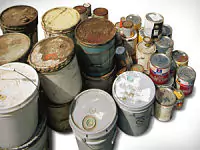Properly dealing with leftover paint not only keeps your home clutter-free but also safeguards the environment from hazardous chemicals. Whether you’ve just finished an interior project or wrapped up some exterior touch-up, understanding how to safely handle old paint is important.

The Leftover Paint Dilemma
Storing old paint in basements or garages might seem harmless, but eventually those cans pile up. Disposing of them carelessly can lead to legal and environmental problems. If you still have paint questions, take a look at our FAQs here for additional insights.
Keep a Little for Touch-Ups
It’s usually a good idea to hold onto a quart or so of your current paint color for quick fixes when dents or scratches appear. Anything beyond that takes up space and may become a burden later.
PaintCare: Great Public Policy
PaintCare is a nonprofit program that helps fund the recycling and proper disposal of unused paint in several states. In places where it’s adopted, a small fee on each paint can supports ongoing collection efforts.
Needs a Push in Kansas and Missouri
Unfortunately, Kansas and Missouri haven’t yet implemented PaintCare. Residents can voice their support for a statewide paint stewardship program by contacting local representatives. Until then, local hazardous waste facilities remain the best option for disposing of leftover paint.
Other Local Recycling Options
While PaintCare isn’t available in Kansas or Missouri, you can still handle old paint responsibly
These facilities accept oil-based and latex paints, stains, and varnishes. Their proper disposal methods keep dangerous chemicals out of landfills and water systems.
Avoid Questionable Methods
Pouring leftover paint down the drain or into a vacant lot might be quick, but it’s illegal and risks hefty fines if traced back to you. Proper disposal ensures compliance with environmental laws and keeps your community safe from pollution.
Practical Ways to Let Paint Dry
If immediate drop-off isn’t possible, you can dry the paint at home so it’s no longer hazardous. Always remember: liquid paint is hazardous, dried paint is simply trash (but confirm local regulations to be sure).
Remove the Lid for a Couple of Months
If there’s only a small amount left, take off the lid and leave the can in a ventilated area. Over time, the paint solidifies and can then be put out with your regular garbage pickup.
Pour into a Larger Container
For moderate quantities, spreading the paint into a shallow container (old baking sheets, cardboard boxes) speeds up drying by increasing surface area.
Drying Oil Paint
Oil-based paint tends to form a skin in the can, leaving liquid underneath. Pour it onto a disposable surface like old carpet scraps so everything dries thoroughly.
Mixing Latex with Kitty Litter
Latex paint can be combined with kitty litter or a commercial hardener. Stir until it solidifies, then dispose of it with normal household waste.
Caution with “Donating”
Providing a small amount to a friend who needs to paint a doghouse or treehouse is usually fine. Offering gallons of paint to an organization can be interpreted as illegal disposal, so when in doubt, use an official hazardous waste facility.
Final Thoughts
If you’re looking for more ways to make your next painting project a success—or if you want to learn about Crestwood Painting’s approach—below are some additional resources you may find helpful:
At Crestwood Painting, we’re committed to delivering top-quality work and eco-friendly practices. Keeping leftover paint out of landfills and waterways is just another way we help protect our community. If you have any questions or want to explore your next project, let’s talk!



